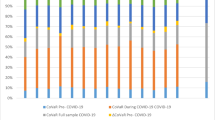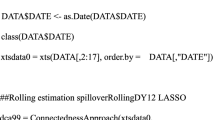Abstract
This study analyzes the impact of VIX spillovers on market activities during extreme market conditions in 42 international equity markets from 1998 to 2014. Specifically, tail cross-dependence suggests that a small change in VIX significantly influences global market activities during extreme market conditions. The impact of VIX is asymmetric, which is more pronounced in bearish, highly volatile, and low trading volume markets. Moreover, VIX spillovers exhibit a stronger impact on returns in developed markets and on volatility in emerging markets. In terms of geographical location, the impact of VIX spillovers is more pronounced on returns in Europe and on volatility in Latin America. These findings indicate that international investors can potentially benefit from international portfolio diversification and can serve as useful guidance to policymakers in designing appropriate policies.









Similar content being viewed by others

Notes
Nevertheless, a number of related studies assess the spillover effect of the CBOE’s implied volatility indices among countries. For instance, Chen (2014) finds significant dependences, contagions, and causalities among the USA, Canada, Japan, and Germany, with the USA being the most dominant market. Moreover, asymmetric dynamic linkages are more pronounced when investor fear rises, particularly during periods of financial crisis. Jiang, Konstantinidi, and Skiadopoulos (2012) find spillover effects of news announcements on implied volatility between the USA and European markets.
White et al. (2015) highlight three main advantages of MVMQ. First, it directly measures tail dependences among interested variables. Second, the model begins from a traditional quantile regression model given by Koenker and Bassett (1978) that is robust to outliers when analyzing a financial time series. Third, the MVMQ model, as a semi-parametric technique, imposes minimal distributional assumptions on the data-generating process. Thus, it offers greater flexibility to estimate coefficients in the model in different market scenarios.
The unit-root test for all variables is less than one, thereby satisfying the stationarity requirement. The AIC optimal lag length is four for all countries. In general, one-way relationships are noted; changes in VIX Granger cause stock market returns, stock market volatility, and stock market abnormal trading volume, respectively, but not vice versa. The results are available upon request.
The Granger causality and VAR results are available upon request.
The sample includes Argentina, Austria, Canada, China, Czech Republic, Hong Kong, India, Indonesia, Japan, Korea, Malaysia, Mexico, Pakistan, the Philippines, Spain, Sweden, Taiwan, Thailand, Turkey, and the UK.
For brevity, we do not present the results of robustness tests. The results of the in-sample and the out-of-sample performance evaluation are available upon request.
References
Abdelhédi-Zouch, M., Abbes, M.B., Boujelbène, Y.: Volatility spillover and investor sentiment: subprime crisis. Asian Acad. Manag. J. Acc. Finance 11(2), 83–101 (2015)
Agbeyegbe, T.D.: Modeling US stock market volatility-return dependence using conditional copula and quantile regression. In: Chichilnisky, I.G., Rezai, A. (eds.) The Economics of Global Environment: Catastrophic Risks in Theory and Policy, 1st edn. Springer, New York (2016)
Ajmi, A.N., Gupta, R., Kanda, P.T.: Causality between economic policy uncertainty across countries: evidence from linear and nonlinear tests. Front. Finance Econ. 11(1), 73–102 (2014)
Allen, D., Singh, A.K., Powell, R.J., McAleer, M., Taylor, J., Thomas, L.: The volatility-return relationship: Insights from linear and non-linear quantile regression (Discussion Paper No. 831). Retrieved from https://repository.kulib.kyoto-u.ac.jp/dspace/bitstream/2433/160704/1/DP831.pdf (2012)
Anderson, T.G., Benzoni, L.: Stochastic Volatility (WP 2009-04). Chicago, Illinois, USA (2009)
Arouri, M.E.H., Jouini, J., Nguyen, D.K.: Volatility spillovers between oil prices and stock sector returns: implications for portfolio management. J. Int. Money Finance 30(7), 1387–1405 (2011). https://doi.org/10.1016/j.jimonfin.2011.07.008
Badshah, I., Frijns, B., Knif, J., Tourani-Rad, A.: Asymmetries of the intraday return-volatility relation. Int. Rev. Financ. Anal. 48, 182–192 (2016). https://doi.org/10.1016/j.irfa.2016.09.016
Bae, J., Kim, C.J., Nelson, C.R.: Why are stock returns and volatility negatively correlated? J. Empir. Finance 14(1), 41–58 (2007). https://doi.org/10.1016/j.jempfin.2006.04.005
Bae, K.-H., Karolyi, A.G.: Good news, bad news and international spillovers of stock return volatility between Japan and the U.S. Pac. Basin Finance J. 2(4), 405–438 (1994). https://doi.org/10.1016/0927-538X(94)90003-5
Baker, S.R., Davis, S.J., Dashkeyev, V., Deriy, O., Dinh, E., Ezure, Y., et al.: Measuring economic policy uncertainty. Q. J. Econ. 131(4), 1593–1636 (2016). https://doi.org/10.1093/qje/qjw024.Advance
Bakshi, G.S., Madan, D.B.: Crash discovery in stock markets. Retrieved from http://www.ssrn.com/abstract=156729 (2006)
Balcilar, M., Gupta, R., Nguyen, D.K., Wohar, M.E.: Causal Effects of the United States and Japan on Pacific-Rim Stock Markets : Causal Effects of the United States and Japan on Pacific-Rim Stock Markets : Nonparametric Quantile Causality Approach (No. Working Paper No. 201595) (2015)
Bandopadhyaya, A., Jones, A.L.: Measures of investor sentiment: a comparative analysis put-call ratio vs. volatility index. J. Bus. Econ. Res. (2011). https://doi.org/10.19030/jber.v6i8.2458
Barberis, N.: The psychology of tail events : progress and challenges. Am. Econ. Rev. 103(3), 611–616 (2013)
Barberis, N., Greenwood, R., Jin, L., Shleifer, A.: Extrapolation and Bubbles (NBER Working Paper No. w21944). Retrieved from http://www.nber.org/papers/w21944.pdf (2016)
Beirne, J., Caporale, G.M., Schulze-Ghattas, M., Spagnolo, N.: Global and regional spillovers in emerging stock markets: a multivariate GARCH-in-mean analysis. Emerg. Mark. Rev. 11(3), 250–260 (2010). https://doi.org/10.1016/j.ememar.2010.05.002
Bekaert, G., Ehrmann, M., Fratzscher, M., Mehl, A.: The global crisis and equity market contagion. J. Finance 69(6), 2597–2649 (2014). https://doi.org/10.1111/jofi.12203
Bloom, N.: The impact of uncertainty shocks. Econometrica 77(3), 623–685 (2009). https://doi.org/10.3982/ECTA6248
Bollerslev, T., Todorov, V., Xu, L.: Tail risk premia and return predictability. J. Financ. Econ. 118(1), 113–134 (2015). https://doi.org/10.1016/j.jfineco.2015.02.010
Brogaard, J., Detzel, A.: The asset-pricing implications of government economic policy uncertainty. Manag. Sci. 61(1), 3–18 (2015). https://doi.org/10.1287/mnsc.2014.2044
Carriero, A., Mumtaz, H., Theodoridis, K., Theophilopoulou, A.: The impact of uncertainty shocks under measurement error: a proxy SVAR approach. J. Money Credit Bank. 47(6), 1224–1238 (2015)
Chen, C.Y.-H.: Does fear spill over? Asia-Pac. J. Financ. Stud. 43, 465–491 (2014). https://doi.org/10.1111/ajfs.12055
Chuliá, H., Guillén, M., Uribe, J.M.: Measuring uncertainty in the stock market. Int. Rev. Econ. Finance 48, 18–33 (2017a). https://doi.org/10.1016/j.iref.2016.11.003
Chuliá, H., Guillén, M., Uribe, J.M.: Spillovers from the United States to Latin American and G7 stock markets: a VAR quantile analysis. Emerg. Mark. Rev. 31, 32–46 (2017b). https://doi.org/10.1016/j.ememar.2017.01.001
Devereux, M. B., Yu, C.: International Financial Integration and Crisis Contagion. NBER Working Paper Series. http://doi.org/10.3386/w20526 (2014)
Diebold, F.X., Yilmaz, K.: Measuring financial asset return and volatility spillovers, with application to global equity markets. Econ. J. 119, 158–171 (2009). Retrieved from http://onlinelibrary.wiley.com/doi/10.1111/j.1468-0297.2008.02208.x/full
Ehrmann, M., Fratzscher, M., Rigobon, R.: Stocks, bonds, money markets, and exchange rates: measuring international financial transmission. J. Appl. Econom. 26(6), 948–974 (2011). https://doi.org/10.1002/jae
French, K.R., Schwert, G.W.W., Stambaugh, R.F.: Expected stock returns and volatility. J. Financ. Econ. 19, 3–29 (1987). https://doi.org/10.1016/0304-405x(87)90026-2
Gupta, R., Pierdzioch, C., Risse, M.: On international uncertainty links: BART-based empirical evidence for Canada. Econ. Lett. 143, 24–27 (2016). https://doi.org/10.1016/j.econlet.2016.03.009
Hamao, Y., Masulis, R.W., Ng, V.: Correlations of price changes and volatility across international stock markets. Rev. Financ. Stud. 3(2), 281–307 (1990)
Hibbert, A.M., Daigler, R.T., Dupoyet, B.: A behavioral explanation for the negative asymmetric return-volatility relation. J. Bank. Finance 32, 2254–2266 (2008). https://doi.org/10.1016/j.jbankfin.2007.12.046
Hoffmann, A.O.I., Post, T., Pennings, J.M.E.: Individual investor perceptions and behavior during the financial crisis. J. Bank. Finance (2013). https://doi.org/10.1016/j.jbankfin.2012.08.007
Jiang, G.J., Konstantinidi, E., Skiadopoulos, G.: Volatility spillovers and the effect of news announcements. J. Bank. Finance 36(8), 2260–2273 (2012). https://doi.org/10.1016/j.jbankfin.2012.04.006
Jurado, K., Ludvigson, S.C., Ng, S.: Measuring uncertainty. Am. Econ. Rev. 105(3), 1177–1216 (2015)
Kelly, B., Jiang, H.: Tail risk and asset prices. Rev. Financ. Stud. 27(10), 2841–2871 (2014). https://doi.org/10.1093/rfs/hhu039
Kim, S.W., Rogers, J.H.: International stock price spillovers and market liberalization: Evidence from Korea, Japan, and the United States. J. Empir. Finance 2, 117–133 (1995). https://doi.org/10.1016/0927-5398(94)00013-7
Klößner, S., Sekkel, R.: International spillovers of policy uncertainty. Econ. Lett. 124(3), 508–512 (2014). https://doi.org/10.1016/j.econlet.2014.07.015
Koenker, R.W., Bassett, G.: Regression Quantiles. Econometrica 46(1), 33–50 (1978). https://doi.org/10.2307/1913643
Koutmos, G., Booth, G.G.: Asymmetric volatility transmission in international stock markets. J. Int. Money Finance 14(6), 747–762 (1995). https://doi.org/10.1016/0261-5606(95)00031-3
Lee, Y.H.: Global and regional range-based volatility spillover effects. Emerg. Mark. Rev. 14(1), 1–10 (2013). https://doi.org/10.1016/j.ememar.2012.09.007
Mensi, W., Hammoudeh, S., Reboredo, J.C., Nguyen, D.K.: Do global factors impact BRICS stock markets? A quantile regression approach. Emerg. Mark. Rev. 19, 1–17 (2014). https://doi.org/10.1016/j.ememar.2014.04.002
Mumtaz, H., Zanetti, F.: The impact of the volatility of monetary policy shocks. J. Money Credit Bank. 45(4), 535–558 (2013). https://doi.org/10.1111/jmcb.12015
Neaime, S.: The global financial crisis, financial linkages and correlations in returns and volatilities in emerging MENA stock markets. Emerg. Mark. Rev. 13(3), 268–282 (2012). https://doi.org/10.1016/j.ememar.2012.01.006
Ng, A.: Volatility spillover effects from Japan and the US to the Pacific-Basin. J. Int. Money Finance 19(2), 207–233 (2000). https://doi.org/10.1016/S0261-5606(00)00006-1
Okimoto, T.: New evidence of asymmetric dependence structures in international equity markets. J. Financ. Quant. Anal. 43(3), 787–816 (2008)
Olsen, R.A.: Behavioral finance and its implication for stock-price volatility. Financ. Anal. J. 54(2), 10–17 (1998). https://doi.org/10.2307/4480062
Padungsaksawasdi, C., Daigler, R.T.: Testing the behavioral approach of the return-implied volatility relation: the 2008 financial crisis versus normal markets. Rev. Futures Mark. 21(4), 479–509 (2014)
Rittler, D.: Price discovery and volatility spillovers in the European Union emissions trading scheme: a high-frequency analysis. J. Bank. Finance 36(3), 774–785 (2012). https://doi.org/10.1016/j.jbankfin.2011.09.009
Rossi, B., Sekhposyan, T.: Macroeconomic uncertainty indices based on nowcast and forecast error distributions. Am. Econ. Rev. 105(5), 650–655 (2015). https://doi.org/10.1257/aer.p20151124
Shefrin, H.: Behavioral Corporate Finance. McGraw Hill, New York (2007)
Simon, D.P., Wiggins, R.A.: S&P futures returns and contrary sentiment indicators. J. Futures Mark. 21(8), 447–462 (2001). https://doi.org/10.1002/fut.4
Takeda, F., Wakao, T.: Google search intensity and its relationship with returns and trading volume of Japanese stocks. Pac. Basin Finance J. 27, 1–18 (2014). https://doi.org/10.1016/j.pacfin.2014.01.003
Whaley, R.E.: The investor fear gauge. J. Portf. Manag. 26(3), 12–17 (2000). https://doi.org/10.3905/jpm.2000.319728
White, H., Kim, T.H., Manganelli, S.: VAR for VaR: measuring tail dependence using multivariate regression quantiles. J. Econom. 187(1), 169–188 (2015). https://doi.org/10.1016/j.jeconom.2015.02.004
Yin, L., Han, L.: Spillovers of macroeconomic uncertainty among major economies. Appl. Econ. Lett. 21(13), 938–944 (2014). https://doi.org/10.1080/13504851.2014.899665
Acknowledgements
Special thanks go to Markus Schmid (the editor), the anonymous referee, Ben R. Marshall, Bart Frijns, Pornchai Chunchinda, Seksak Jumroenvong, Tatre Jantarakolica, and Termkiat Kanchanapoom for their suggestions and comments. We also thank Maria E. De Boyrie (the discussant) and the participants of the 2016 Annual Auckland Finance Meeting.
Author information
Authors and Affiliations
Corresponding author
Rights and permissions
About this article
Cite this article
Cheuathonghua, M., Padungsaksawasdi, C., Boonchoo, P. et al. Extreme spillovers of VIX fear index to international equity markets. Financ Mark Portf Manag 33, 1–38 (2019). https://doi.org/10.1007/s11408-018-0323-6
Published:
Issue Date:
DOI: https://doi.org/10.1007/s11408-018-0323-6



